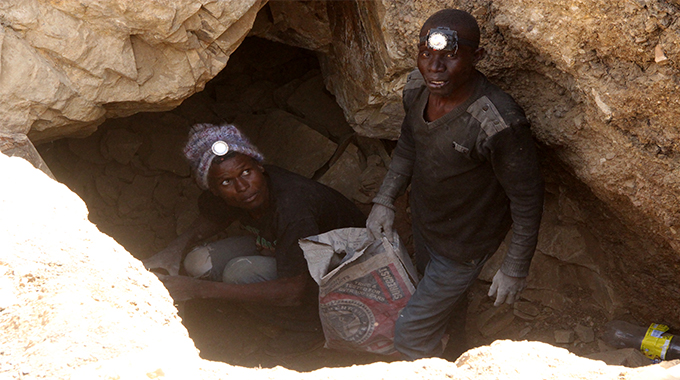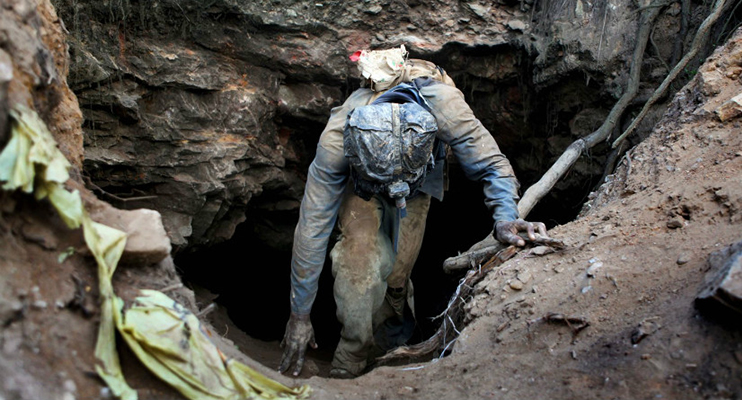At a small mining community in Battlefields near Kadoma, about 157 km south west of the capital, jobless people sit under trees to escape the burning sun.

It is the same place where 26 artisanal gold miners perished underground when a dam upstream burst its walls and flooded tunnels. The tragedy occurred earlier this year in February while the poorly equipped panners were underground.
Only eight of them managed to come out alive. They had been trapped for days underground at the Cricket and Silver Moon mine. Many more others were not so lucky – they were removed from the mines as cadavres.
Even though venturing into the disused mine remains dangerous – panners say they have no option but to be brave. After all there are no jobs and they have families to feed.
Rosemary Maruza, wife of one of the survivors, says on the fateful day, her husband did not want to go to the mine. He had complained that he was tired.

“At first, my husband did not want to go there, but later on, he changed his mind saying he wanted to see his friend. Later that day, news filtered that the mines had been flooded,” recalls Maruza.
“I realised that he had entered the shaft and I concluded that I would never see him again. I had no hope at all. My worry was about our two young children.”
Fortunately her fears worst fears came to pass when rescuers brought her husband to the surface – he was alive.
“I was overwhelmed with joy when he was the first to be rescued. It was by the grace of God that he survived,” said Maruza.
“As he was being taken into a waiting ambulance, he waved at me with a smile.”

Despite the difficulties they face owing to scarce job opportunities, Maruza says she no longer wants her husband to go back underground.
But for many young men in the area it remains the only possibility of earning a living.
Young men, some of the survivors of the flooding, continue to go back into the dangerous tunnels in search of gold.
“It is a win-win situation, they are returning to the same mining fields that robbed them of their friends,” surmises Oliver Tseurai, a mining mill owner.
“What is of concern is the issue of ventilation, whereby carbon monoxide is released underground and they breathe it while down there.”
There are abandoned mines in the area and panners can not resist the allure of gold that may still be scrapped out from deep beneath the earth.

It’s a dangerous task, but still they carry on, and lift sack loads of ore to the surface, some of which weigh as much as 35 kg.
For the miners, it is a life-threatening adventure as they have to go even as deep as 40 m, in the process inhaling dust from the blasting of ore.
“This is part of the work. Even in formal work places, accidents are bound to happen,” says Thomas Chitsa, an artisanal miner.
“It’s only that it happened here, but the truth is where there is money, there are risks.”
Zimbabwe’s struggling economy depends mostly on agriculture, but in this area no one is tilling any fields.
Only sounds of ball mill crushers at work conquer this usually tranquil environment.

Zimbabweans living in areas where there are abandoned gold mines have ventured into artisanal mining, which has become a major source of income for jobless young people.
At law, they are recognised as artisanal miners. Though not regularised, they contribute more than half of the country’s production.
In 2018, the informal sector contributed two-thirds of output to the government buyers, Fidelity Printers and Refiners.
Rodwell Nyausaru, an engineer, explains that exploration is done on a trial and error basis.
“These miners do not need detectors. Their exploration is conducted on a trial and error basis. They rely on instincts and experience accumulated in a particular geographical area,” he says.
Gold mining has been attributed with the bad and good side. For the lucky ones, a fortune defines destiny.
Many have gone to improve their homes and have regularised their operations by registering with authorities.
The money has attracted vice in the area – prostitution and robbers carried out using machetes are on the rise.
Recently, the Zimbabwe Republic Police placed a ban on the carrying of machetes in the public as it moved to put a stop to their use.

Apart from the vice, gold mining is a gamble for these artisanal miners. They do not know if the ore in the heavy sacks are worth carrying out of the tunnels.
“It is not a secure venture. At times, you carry very heavy sacks yet what you get in return is little, or even nothing,” Chitsa says.
The miners claim that they are selling the yellow metal at a paltry $100 in local currency per gramme.
“We are selling the gold at between $90 and $100, which is way below what the buyers are getting in US dollars. We hear they sell it at US$40,” another artisanal miner said.
In light of the Battlefields disaster, government said it would introduce a new mining bill to regulate artisanal miners.
Legal and parliamentary affairs minister, Ziyambi Ziyambi, said: “The ministry of mines is in the process of capacitating small-scale miners to work in groups or syndicates, and they will be given equipment to ensure that their mining activities become safe”.
He said Parliament was looking at how to regulate artisanal miners in order to get them to adhere to safety measures.
“Even when they are told that there is danger, they continue to mine in those mines. For example, at Eldorado Mine in Chinhoyi, they go there at night, despite the fact that the mine has been condemned,” Ziyambi said.
Mines and mining development minister, Winston Chitando, said two weeks before the tragic drowning of the 26 artisanal miners at the Battlefields mine, the Environmental Management Agency had raised a red flag over safety conditions at the two mines, but the warnings were ignored.
The Mines and Minerals Bill was first brought before Parliament in 2015 to amend the colonial law, which had become outdated. Considerations being looked at include issues pertaining to artisanal miners as well as prospectus. African News Agency/ANA





